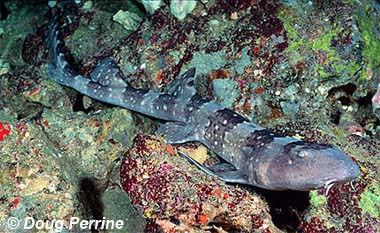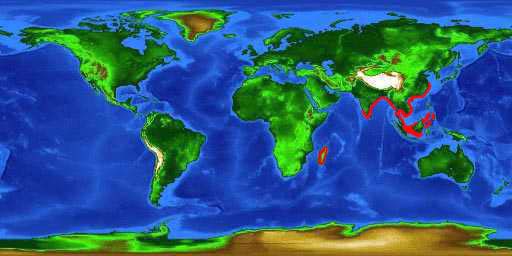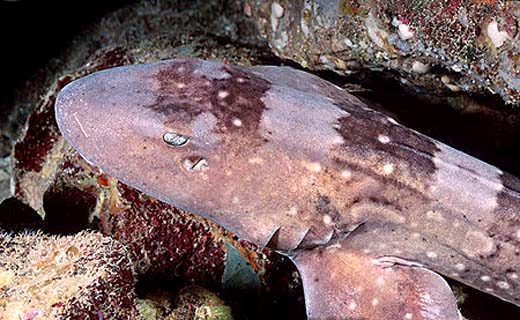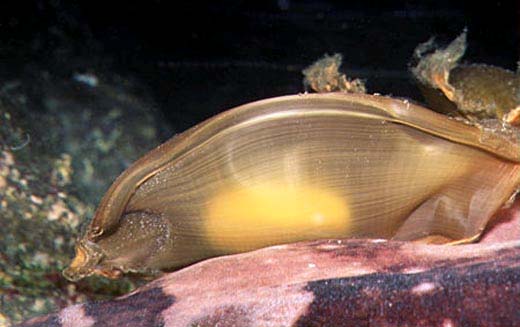
Chiloscyllium plagiosum
These small carpet sharks are nocturnal reef-dwellers. They are very elongated and narrow, with lobed fins and rounded snouts, and only grow to between 24 and 37 inches long. They are brown, with darker brown bands, and are scattered with white and black spots. Because of their size and adaptability, they are popular in public aquariums.
Order – Orectolobiformes
Family – Hemiscylliidae
Genus – Chiloscyllium
Species – plagiosum
Common Names
English language common names are whitespotted bambooshark, catshark, bluespotted bamboo shark, white-spotted bamboo shark, white-spotted bambooshark, and white-spotted catshark. Other common names are bamboa punteada (Spanish), chalarm Gob (Thai), hvidplettet bambushaj (Danish), pating (Tagalog), raitapartahai (Finnish), requin-chabot taches blanches (French), shiroboshi-tenjiku (Japanese), shiroboshitenjiku zame (Japanese), witgestippelde bamboehaai (Dutch), yu bodoh (Malay), and Žralok bambusový beloskvrnný (Czech).
Importance to Humans
The whitespotted bambooshark is used for human consumption and in traditional Chinese medicine. This species is often caught by hook and line and in trawls off India, China, and Thailand. It is marketed for human consumption in Madagascar. It adapts well and reproduces in captivity and is on display at many public aquarium facilities in Europe and the US.
Danger to Humans
Bamboo sharks are harmless to humans, spending much of their lives along the bottom substrate in search of prey items.
Conservation
> Check the status of the whitepotted bamboo shark at the IUCN website.
The IUCN is a global union of states, governmental agencies, and non-governmental organizations in a partnership that assesses the conservation status of species.
Geographical Distribution

The whitespotted bamboo shark is found in the Indo-west Pacific region including waters off Madagascar, India, Sri Lanka, Singapore, Thailand, Indonesia, Viet Nam, China, Taiwan, Japan, the Philippines, and probably Malaysia. This species has also been reported off Korea.
Habitat
This demersal bamboo shark lives in inshore subtropical and tropical reef-associated waters within its distribution range. The long slender body shape of this species lends itself well to gliding along coral reefs. Currently, there is little known about the life history of the whitespotted bambooshark.
Biology

Distinctive Features
The body of the whitespotted bamboo shark is stout with a rounded snout. There are spiracles located below the eyes. There are sensory barbels located near each nostril. There is a lateral ridge on each side of the trunk of this shark. The two dorsal fins are of equal size, that being of approximately the same size as the pelvic fins. The origin of the first dorsal fin is positioned over the insertion of the pelvic fins. The pectoral fins are muscular and flexible and can be used to crawl along the bottom. The anal fin terminates just anterior to the caudal fin. The length of the precaudal tail is much longer than the body and head combined. The caudal fin has a pronounced subterminal notch; there is no ventral lobe present on this species.
Coloration
The body is dark brown with some dark transverse bands as well as numerous irregular white or bluish spots. Although there are other bamboo sharks that are similar in appearance to the whitespotted bambooshark, this species can be distinguished from others by its unique coloration pattern.
In captivity, there have been three albino whitespotted bamboosharks hatched at Sea World in Orlando, Florida (US).
Dentition
The teeth of bamboo sharks (Family: Hemiscylliidae) are not strongly differentiated in the upper and lower jaws. Each tooth has a medial cusp and weak labial root lobes. The number of tooth rows of species in this family ranges from 26-35 (upper jaw)/21-32 (lower jaw). The teeth are used to clutch soft-bodied prey as well as to crush hard-bodied prey items.
Denticles
There are lateral dermal ridges along the body of the whitespotted bambooshark.
Size, Age & Growth
The maximum reported length of a female whitespotted bambooshark is 37.4 inches (95cm) total length (TL); the maximum reported length of a male specimen of this species is 32.7 inches (83cm) TL. However, the average size of an adult ranges from 23.6-31.5 inches (60-80cm) TL. It is known that males and females reach sexual maturity at total lengths of approximately 25.6 inches (65cm). Free-living specimens or hatchlings measuring 3.9-4.9 inches (9.8-12.5cm) in length have been documented.
Food Habits
Although not well documented, it is believed that the nocturnal whitespotted bamboo shark feeds primarily on small marine fishes and invertebrates.

Reproduction
This bamboo shark is oviparous. The mating season for this species off the Taiwanese coast takes place in December and January while ovulation occurs from March through May suggesting that females may be able to store sperm. One or two round egg cases are released every six to seven days on average for approximately two months. The young emerge approximately 100-110 days after the egg cases are released from the female.Predators
Potential predators of the whitespotted bamboo shark include larger fish such as sharks as well as marine mammals.
Parasites
Heliconema minnanensis n. sp. (Physalopteroidae: Physalopteridae) have been collected from the stomach of whitespotted bamboo sharks from Taiwanese waters. In addition, the cestode Yorkeria xiamenensis n. sp. has been described from the spiral valve of this species in the coastal waters off China.
Taxonomy
The whitespotted bamboo shark was originally described by the English zoologist Edward Turner Bennett in 1830. It is a member of the family Hemiscyllidae which consists of bamboo sharks and carpet sharks. Originally named, Scyllium plagiosum, the whitespotted bamboo shark’s scientific name was later changed to the currently valid Chiloscyllium plagiosum. The genus name, Chiloscyllium, is derived from the Greek “cheilos” meaning lip and “skylla” defined as a kind of shark. In past scientific literature, synonyms for this species include include Scyllium ornatum Gray 1830, Chiloscyllium plagiosum var. interruptum Bleeker 1852, and Scyllium plagiosum var. interruptum Bleeker 1852.
Prepared by: Cathleen Bester